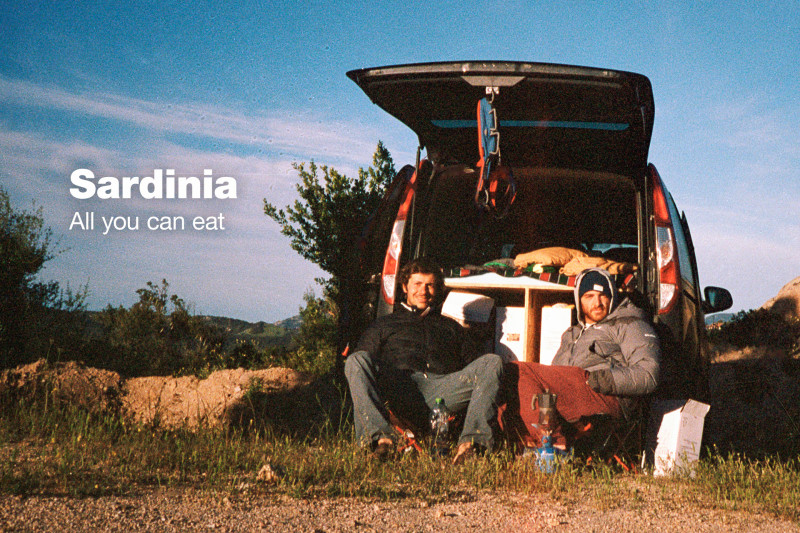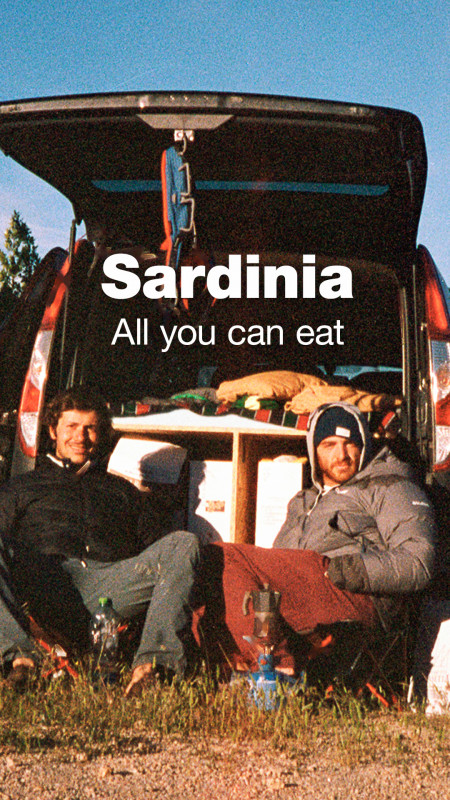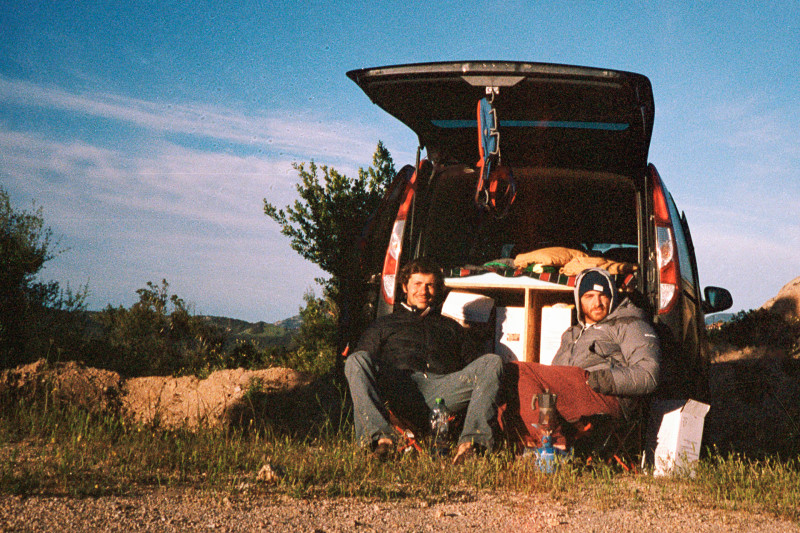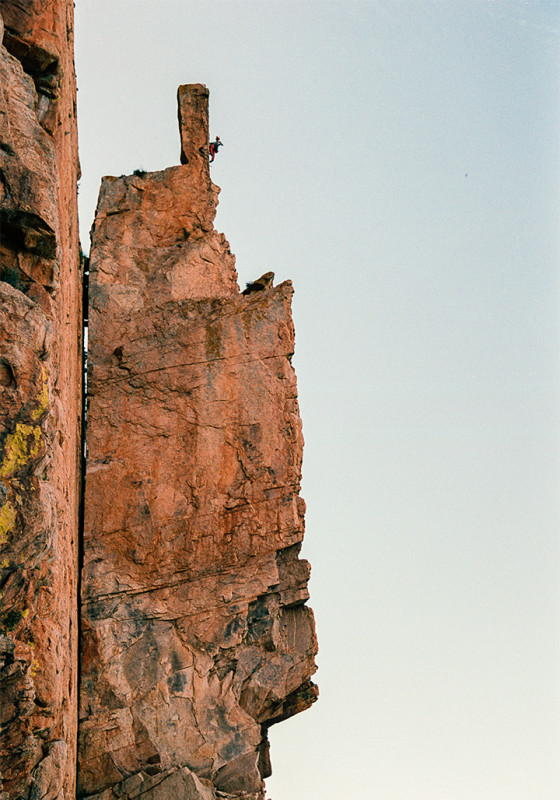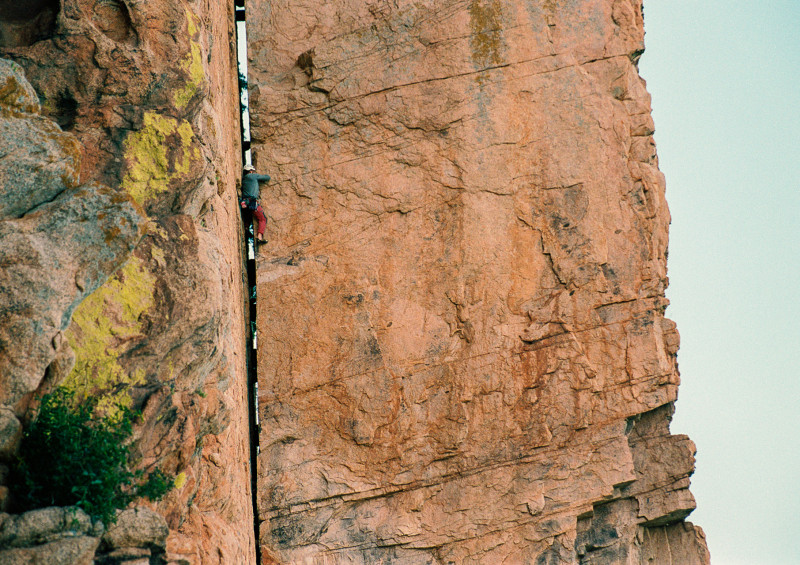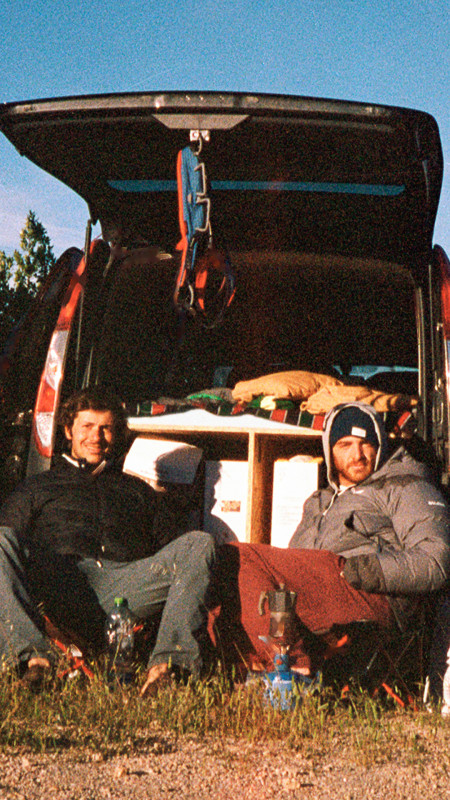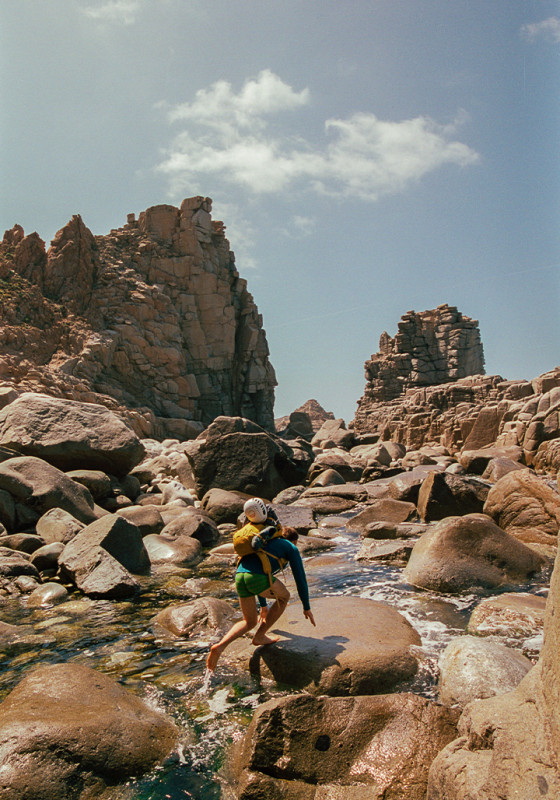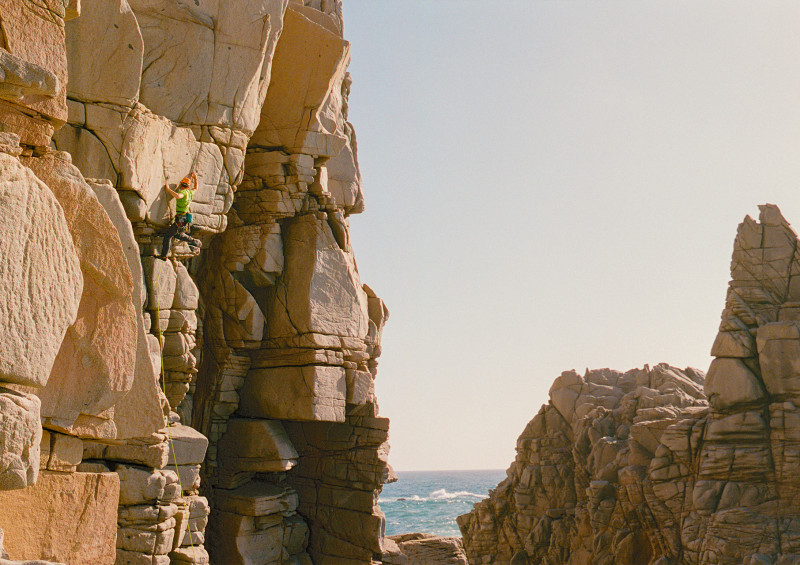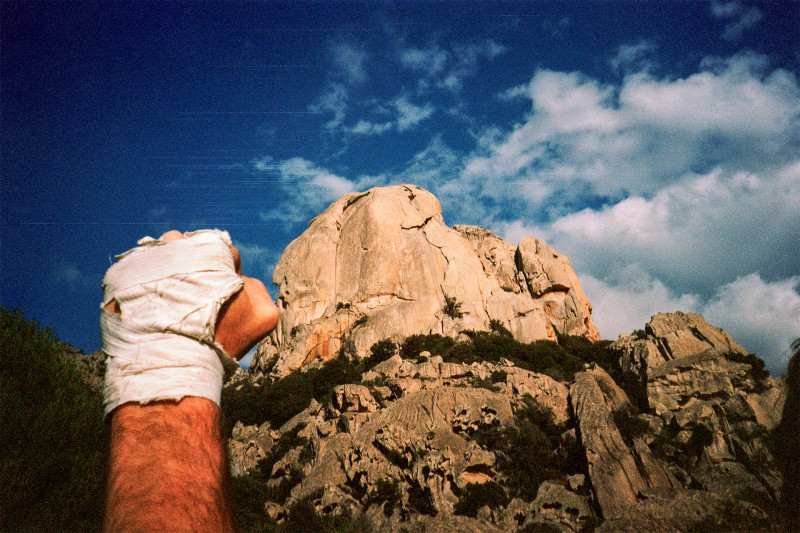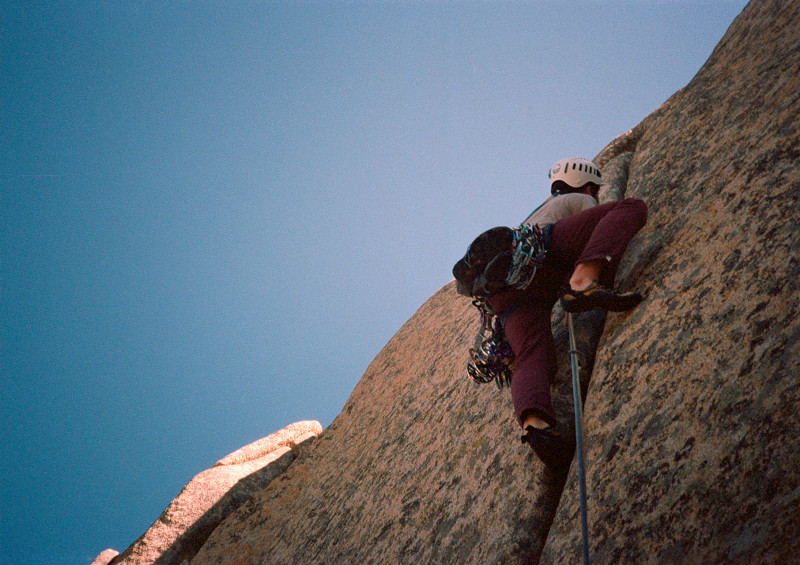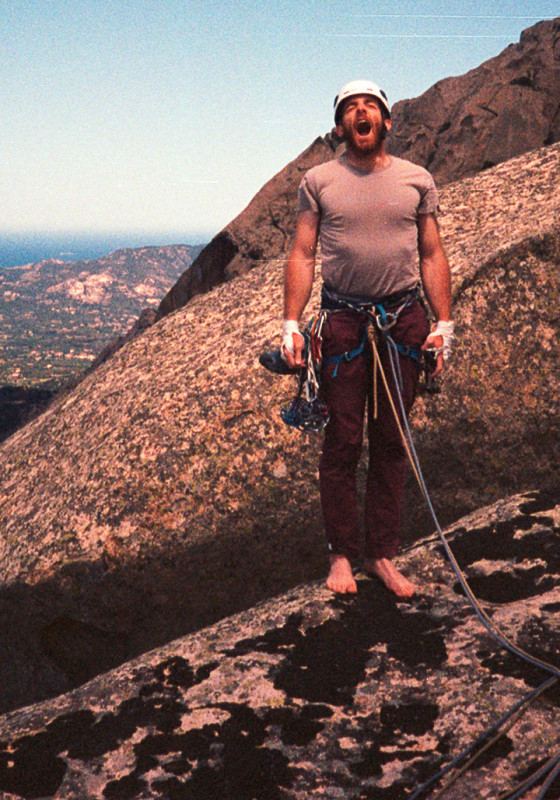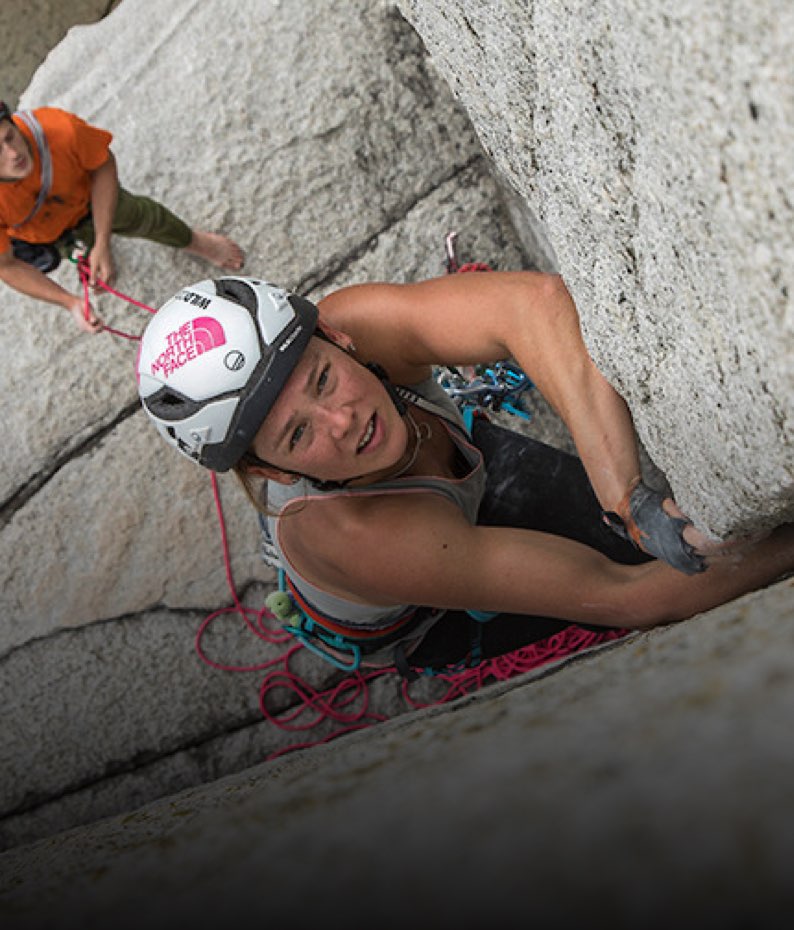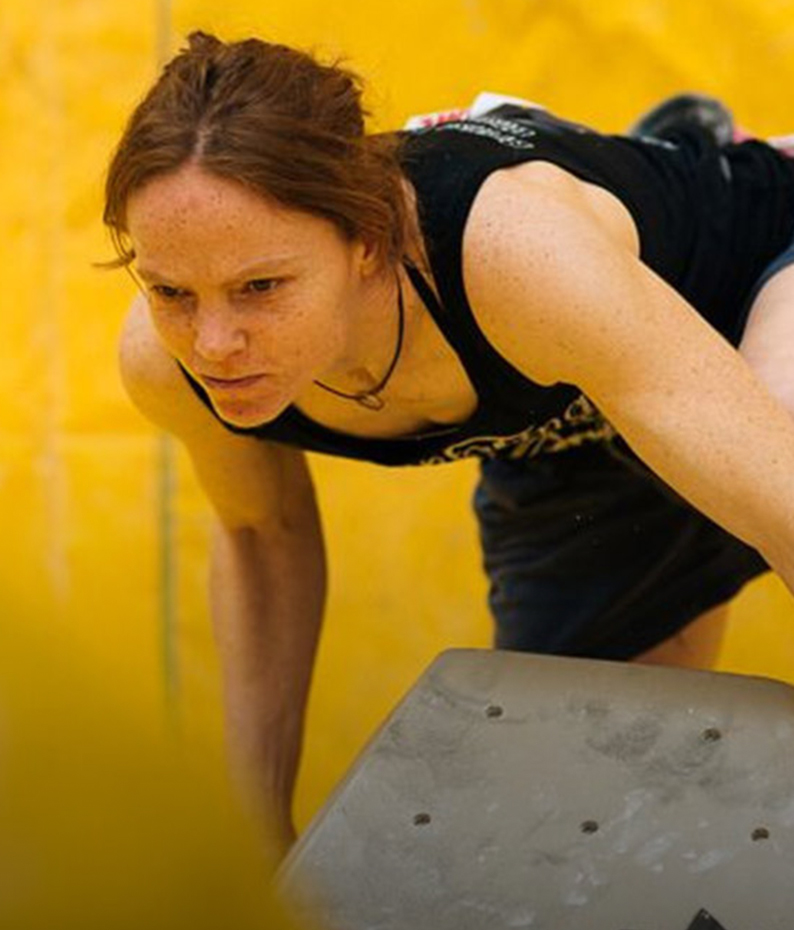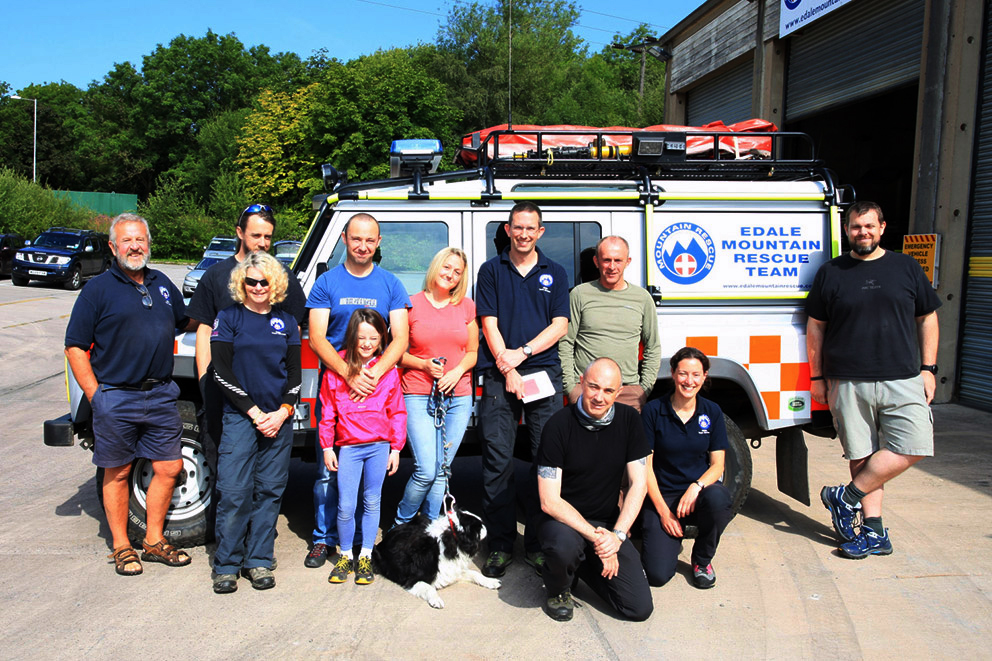translation needed
You have to go to Sardinia when you want to get lost.
Lost among the vestiges of juniper-laden paths, or maybe in the midst of rocky plateaus. Lost climbing a wall, while you try to decode the furrows of the limestone towards the next bolted anchor. Or perhaps lost at the top, when you find out that the belay station has to be set up on a bush a few metres further ahead. It also means getting lost when choosing what to do and where to do it. Few places in the world offer such a varied menu for avid climbers: granite, basalt, limestone, multi-pitch climbs, bolted single pitches, trad cliff faces and bouldering rocks.
Our plan is quite simple: between the outward and inward bound ferries, we have ten days to climb as much as possible and to try and sample the most delicious dishes on the menu. And we have a particular fondness for dishes built around trad and multi-pitch climbs. Two of us turn up at the port of Livorno, with a minivan packed with everything we need for our climbing feast: three sets of friends, two sets of nuts, enough quickdraws to last us, half ropes and single ropes, comfortable and not so comfortable climbing shoes, trousers and shorts, sleeping bags, pots, a crate of beer and a basil plant. A couple of cameras, three rolls of colour film and a roll of black and white. We also have Edo with us, he’s one of those people you become friends with because you can understand one another without saying a word. What happened afterwards is a long showreel of memories, in some of the most beautiful places I've seen with a harness around my hips and my climbing shoes on my feet.
We got lost amidst the dreamlike shapes of the Valle della Luna. Here, over 30 years ago, climbers migrated from the Val di Mello in search of crevices and visions. This was usually induced by hallucinogenic substances, even though the landscape itself could easily have lent a helping hand. We realised that perhaps we should have brought bigger friends, or simply bigger balls to face up to those off-width pitches which offer no hope of protecting yourself.
Translation needed
We lost ourselves in the beauty of the limestone rock in Ogliastra. There, we managed three bolted multi-pitch climbs on three different faces. "La mia Africa" at Monte Oddeu is a stretch of mountain which looks as if it has been stolen from the Verdon Gorge. There you can spoil yourself with pitches on perfect grey limestone and an endless amount of routes of different grades with a ridiculous approach. Next on our list was the Pedra Longa rock monolith. The "Marinaio di Foresta" is not a tough route. Quite the opposite. And the pitches aren't always all that fun. The rock is also incredibly rough and painful. Instead of looking for better holds, you rely on less sharp ones. So why do it? Well, because climbing with the entire gulf of Baunei before your eyes, just a few metres above sea level, is a multi-sensory experience that will stay with you long after you get back home. And because Punta Giradili, the face that we were going to tackle the next day, stands right in front of it, just a few kilometres away. We had first passed beneath a few years ago, when we climbed the Selvaggio Blu, a trek that goes from Pedra Longa to Cala Gonone along 50 kilometres of wild coast with almost no trails. At the time, we just had a look at the bolted anchors that we could see here and there, dreaming about a possible future when we would come back to climb that wall. The only thing we knew was its name.
We took the Mediterraneo route to climb to the top of Punta Giradili, which is probably one of the most beautiful rock faces overlooking the Mediterranean Sea. It is a limestone rock that starts out grey at the bottom and becomes red on top. The quality borders on perfection. Once at the peak, you can't help but sit for a few minutes and let your gaze roam over endless kilometres of rock and sky, all framed by the blue of the sea.
After the thrill of Punta Giradili, we continued on our way towards the south of the island. On the coast of Supramonte, anyone willing to walk an hour can get to the Jurassic Park crag, a granite wall that is literally in the middle of nowhere. We purposefully came here to climb to the top of the Dillosauro. Its finger - little wider than a seat - has become famous for its spectacular shape. To get there, you need to climb a long off-width crevice, using the Dulfer technique or, for the purists out there, the body jam technique. In addition to the Dillosauro, this crag also has other bolted and trad routes, which you can mainly climb using jams.
By this point, a fair few days had gone by and we still hadn't stopped: the rest day we'd planned had been sacrificed to get to Jurassic Park, because we wanted to climb a lot more than the skin on our fingers would have liked. But you know how it is better than me. When you’re faced with certain walls, your hands start to sweat and all you want to do is get your harness on and get going.
The next course was to be one of the main dishes of our trip: the trad area of Capo Pecora, located on the southwest coast of the island. In recent years, a vast area of 15 to 50-metre-high granite towers has been explored. Right by the sea, the horizontal and vertical crevices of these towers are perfect for placing friends. Our only problem would be the wind. Indeed, when the mistral blows, the salt residue lands on the granite, making it slippery. The waves could also make access a little more "complicated".
There are not many words that could do justice to the beauty of this place, particularly the stretch of coast that you must walk before you get to the real cliff face. The collective image of climbing in Sardinia is based on great limestone faces and wild woods. Yet here, you could be in Ireland, if it weren't for the scents of the Mediterranean scrub. When we were there, the rough sea and the light at sunset made it all the more thrilling. And as the only spectators to this natural spectacle, our emotions intensified.
Climbing is a funny game. There are days when you just feel heavy and clumsy. The only memory you take home is your frustration, which makes you ignore all the rest. Yet there are the other days when "the rest" makes you happy, despite the fact that you are tackling climbs that are not much beyond beginner’s standard. And in the afternoon, in Capo Pecora, when the sun dips in the sky and the waves swell, “the rest" transforms into golden light and the smell of salt, which you savour while looking for the best piece to protect you on the white and grey granite with one hand.
There are not many words that could do justice to the beauty of this place, particularly the stretch of coast that you must walk before you get to the real cliff face. The collective image of climbing in Sardinia is based on great limestone faces and wild woods. Yet here, you could be in Ireland, if it weren't for the scents of the Mediterranean scrub. When we were there, the rough sea and the light at sunset made it all the more thrilling. And as the only spectators to this natural spectacle, our emotions intensified.
Climbing is a funny game. There are days when you just feel heavy and clumsy. The only memory you take home is your frustration, which makes you ignore all the rest. Yet there are the other days when "the rest" makes you happy, despite the fact that you are tackling climbs that are not much beyond beginner’s standard. And in the afternoon, in Capo Pecora, when the sun dips in the sky and the waves swell, “the rest" transforms into golden light and the smell of salt, which you savour while looking for the best piece to protect you on the white and grey granite with one hand.
On the ninth day, we were forced to raise the white flag. We started having pains here, there and everywhere. This, combined with the sluggish pace at which we ate our breakfast told us that perhaps it would have been best to do something else. First and foremost, we had to clean our camp, which meant the - possibly futile - attempt to make some sense of the disorder in our minivan. Because, after all, to climb you need to welcome disorder into your life. You take holidays at odd times of the year. You grumble when your "normal" friends ask if you'll be heading to the mountains this weekend as well. Then, we tried to figure out how best to use the day. And that’s how we ended up walking among the murals of Orgosolo. This town, situated in the heart of Supramonte, has a bloody past of clan wars and shoot-outs, which has been replaced by a present filled with art and gastronomy. If we’re being honest, we also ended up tasting Cannonau wine and feeling decidedly out of place. The neat clothing of the French group that was with us clashed with our dirty trousers and ruffled hair. Yet we were all in agreement when it came to how delicious the wine was.
The last day was perhaps the best of our trip. It was also maybe because we had absolutely no expectations on what awaited us. The destination was the panettone-shaped rock of Lu Lurusincu, in Gallura, a few kilometres from the port of Olbia. The guidebook merely observed that it was one of the most beautiful granite rock faces on the island. Beyond that, we didn't find anything else.
On the ninth day, we were forced to raise the white flag. We started having pains here, there and everywhere. This, combined with the sluggish pace at which we ate our breakfast told us that perhaps it would have been best to do something else. First and foremost, we had to clean our camp, which meant the - possibly futile - attempt to make some sense of the disorder in our minivan. Because, after all, to climb you need to welcome disorder into your life. You take holidays at odd times of the year. You grumble when your "normal" friends ask if you'll be heading to the mountains this weekend as well. Then, we tried to figure out how best to use the day. And that’s how we ended up walking among the murals of Orgosolo. This town, situated in the heart of Supramonte, has a bloody past of clan wars and shoot-outs, which has been replaced by a present filled with art and gastronomy. If we’re being honest, we also ended up tasting Cannonau wine and feeling decidedly out of place. The neat clothing of the French group that was with us clashed with our dirty trousers and ruffled hair. Yet we were all in agreement when it came to how delicious the wine was.
The last day was perhaps the best of our trip. It was also maybe because we had absolutely no expectations on what awaited us. The destination was the panettone-shaped rock of Lu Lurusincu, in Gallura, a few kilometres from the port of Olbia. The guidebook merely observed that it was one of the most beautiful granite rock faces on the island. Beyond that, we didn't find anything else.
A search on the internet turned up hardly any information, and little else on the massif of Torri di San Pantaleo. At this point, it was worth going to have a look, armed with friends, as many as possible, and cordelettes, given that in Gallura most of the routes have no pitons, belay stations included, and often the descents on foot are more complicated than the climbs, as well as the approaches. And so it was, almost by chance, that we ended up climbing the perfect crevice of Il passo del giaguaro: There were 45 metres of handholds and fist jams, followed by two slab pitches where it was crucial that we trusted our feet and stayed calm. The whole experience was so amazing that we did it a second time. We then moved on to the Fessura del Traditore, which was also incredible. Then we had to run for the van, without even having time to take off our harnesses. Unfortunately, we had to catch the ferry.
Sardinia gave us what we wanted: a series of excellent routes, in the widest range of styles, where we were almost always alone. Of course, the world of climbing can do without our (meagre) performances. In the end, however, we won’t be the ones who will push the level forward. At most, us common mortals are responsible for defending the fundamental values of this game, which - in some ways - also make up its rules: curiosity, friendship, love for our surroundings and, more than anything else, a desire to get lost.
A search on the internet turned up hardly any information, and little else on the massif of Torri di San Pantaleo. At this point, it was worth going to have a look, armed with friends, as many as possible, and cordelettes, given that in Gallura most of the routes have no pitons, belay stations included, and often the descents on foot are more complicated than the climbs, as well as the approaches. And so it was, almost by chance, that we ended up climbing the perfect crevice of Il passo del giaguaro: There were 45 metres of handholds and fist jams, followed by two slab pitches where it was crucial that we trusted our feet and stayed calm. The whole experience was so amazing that we did it a second time. We then moved on to the Fessura del Traditore, which was also incredible. Then we had to run for the van, without even having time to take off our harnesses. Unfortunately, we had to catch the ferry.
Sardinia gave us what we wanted: a series of excellent routes, in the widest range of styles, where we were almost always alone. Of course, the world of climbing can do without our (meagre) performances. In the end, however, we won’t be the ones who will push the level forward. At most, us common mortals are responsible for defending the fundamental values of this game, which - in some ways - also make up its rules: curiosity, friendship, love for our surroundings and, more than anything else, a desire to get lost.

Sardinia - All you can eat
Granite, basalt, limestone, multi-pitch climbs,
bolted single pitches, trad cliff faces and bouldering rocks.
Blog and pictures by Federico Ravassard
Sardinia - All you can eat
Granite, basalt, limestone, multi-pitch climbs, bolted single pitches, trad cliff faces and bouldering rocks.
Blog and photos by Federico Ravassard

